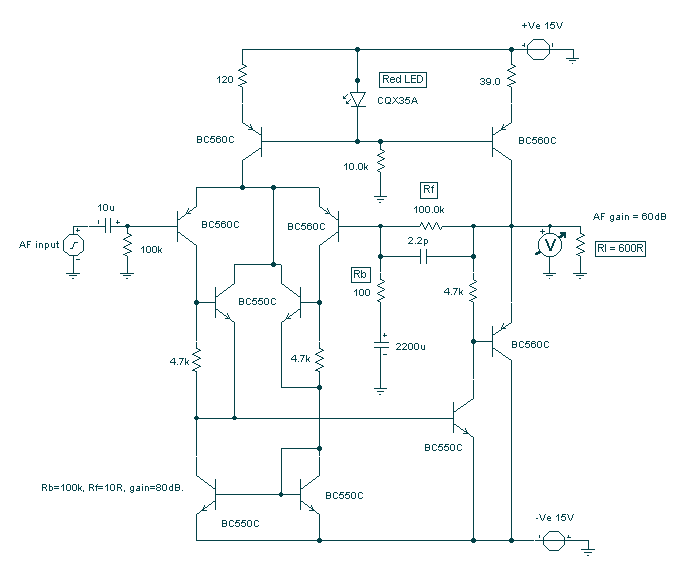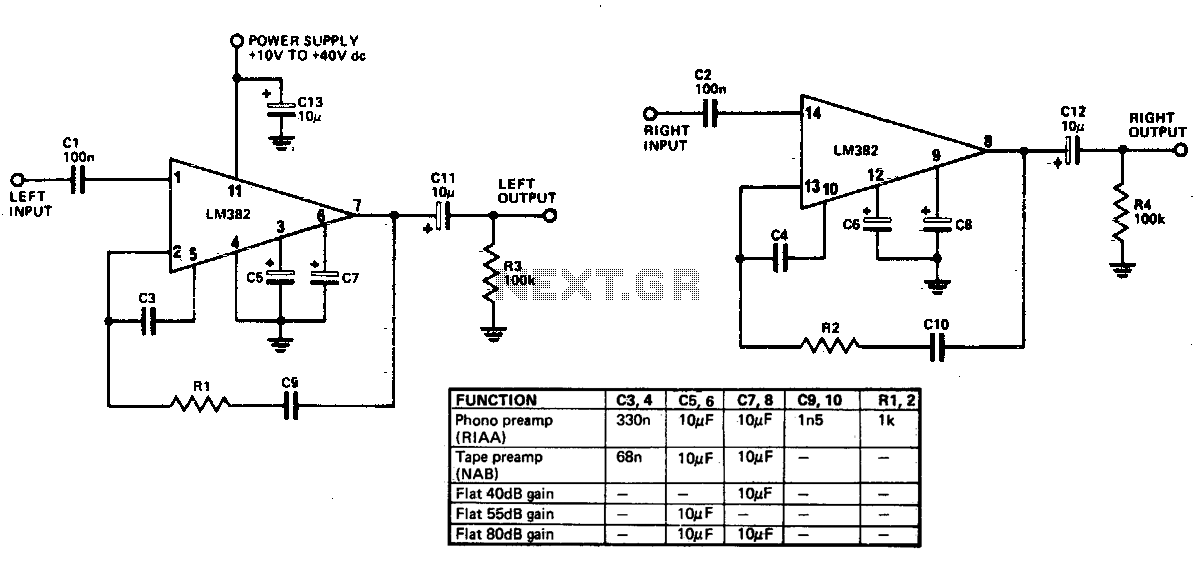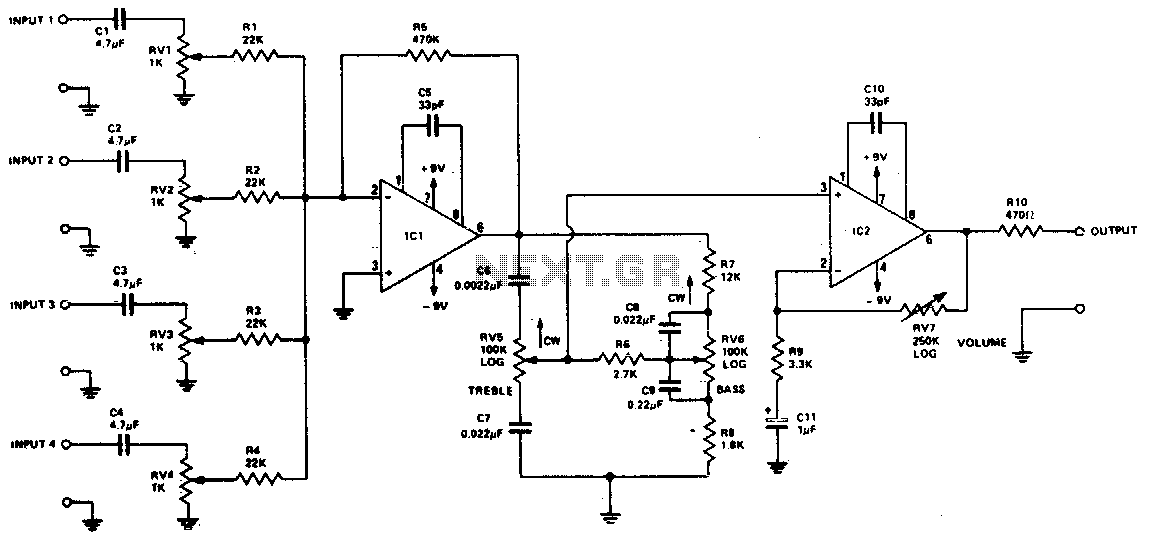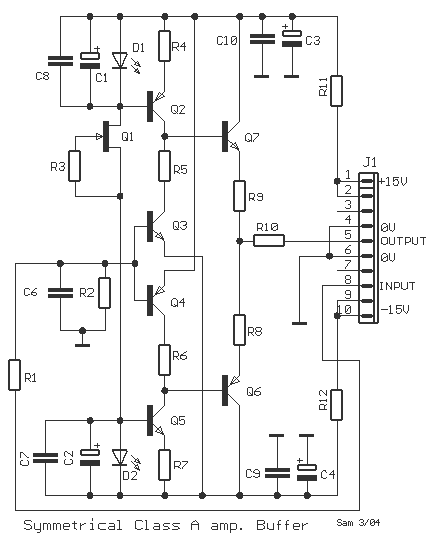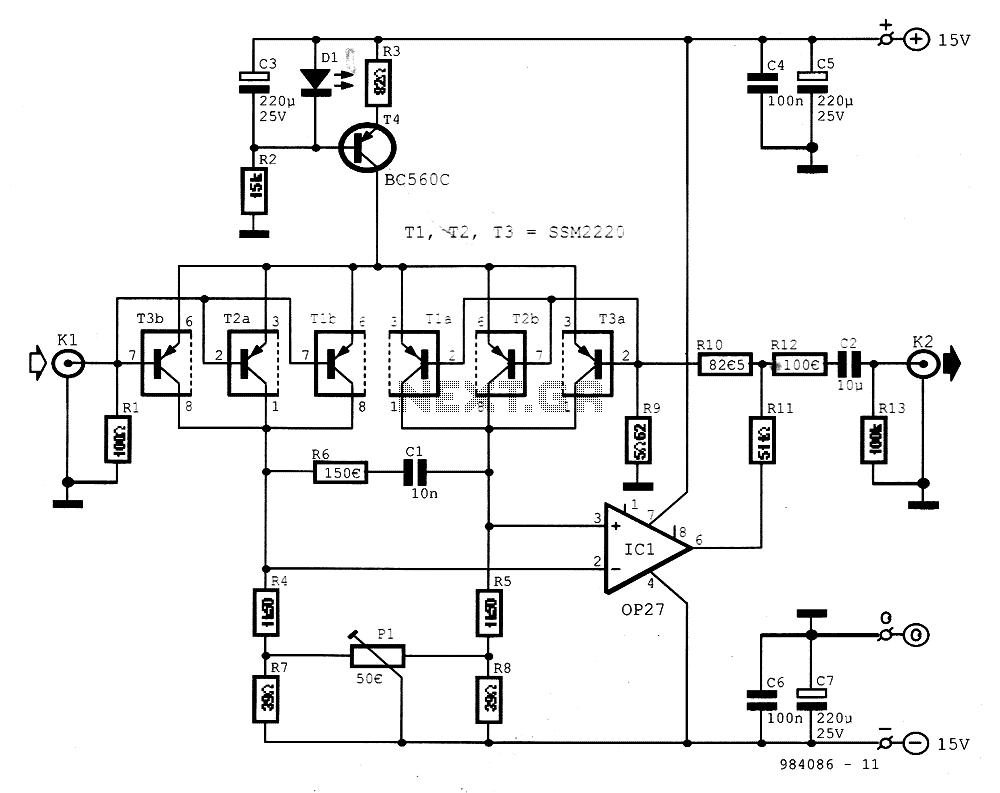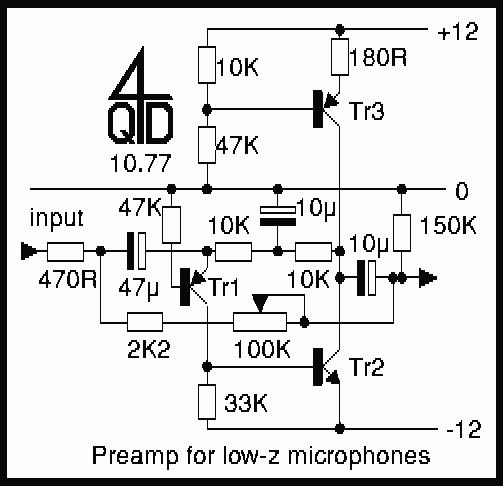
A Studio Preamplifier
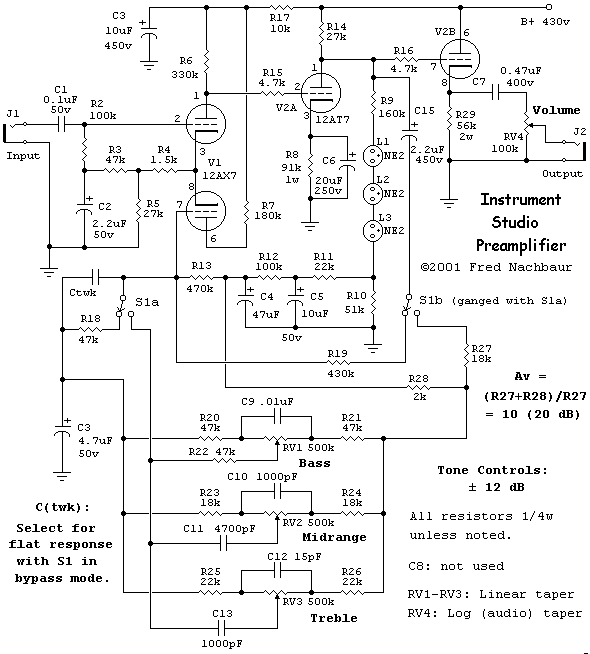
The initial request was for a flexible preamplifier suitable for a high-end acoustic guitar equipped with a piezoelectric bridge pickup, while the second inquiry involved a preamp for a guitar emulator to introduce warmth reminiscent of vacuum tubes. Both requirements can likely be addressed through a variation of the Universal Tube Preamp design. The RA-100 Reference Amplifier has been utilized for similar applications, providing clean, noise-free amplification along with unobtrusive tone controls, making it an ideal preamplifier for musical instruments. However, for a dedicated standalone preamplifier, potentially rack-mountable, certain modifications to the universal preamp design can enhance and customize it for musical instrument use. As of this writing, this specific variant of the Universal Preamp design has not been constructed, and reports on its implementation would be appreciated. The project is categorized as "advanced" due to potential tweaks required, although the design and construction are not particularly complex. The schematic of the modified preamplifier circuit has been redrawn for better web compatibility, with a high-resolution version available for download. This iteration is a revised version of the tone control preamp section from the RA-100, which may be referenced for operational theory. Key differences include the use of a "quasi op-amp" in a non-inverting configuration, as opposed to the RA-100's inverting mode. The non-inverting mode is favored for studio applications as it preserves the original signal phase, which is beneficial when mixing the preamp output with the input signal. Additionally, this mode maintains a constant input impedance unaffected by tone control settings, which is crucial for general-purpose studio preamps. The gain calculations differ slightly between the two modes, particularly at lower gain settings. The triple-T tone control network adjusts both input and feedback impedance values with any pot adjustments, resulting in a slight reduction in maximum "cut" compared to maximum "boost." Nevertheless, the advantages of fixed input impedance and phase preservation in studio applications outweigh this minor drawback. The original circuit incorporates a 12AX7 differential amplifier and half of a 12AT7 dual triode for the output stage for each channel in a stereo setup, leaving one 12AT7 triode available in a monaural configuration. This leftover triode can be utilized as a common-plate (cathode follower) stage, ensuring a consistent output.
The modified preamplifier circuit is designed to enhance the performance of acoustic instruments and guitar emulators by leveraging the unique characteristics of vacuum tube technology. The use of a quasi op-amp in non-inverting mode allows for high fidelity and phase integrity, essential for professional audio applications. The circuit is structured to ensure that the input impedance remains stable, which is vital for interfacing with various musical instruments that may exhibit differing output characteristics.
The triple-T tone control network is a sophisticated addition that offers versatile sound shaping capabilities. By simultaneously adjusting both input and feedback impedance, it allows musicians to fine-tune their sound while maintaining the integrity of the signal. This feature is particularly beneficial in studio environments where precise control over tonal characteristics is required.
The choice of using a 12AX7 for the differential amplifier stage contributes to the warmth and richness of the audio signal, characteristics that are highly sought after in high-end audio applications. The incorporation of a cathode follower stage utilizing the spare triode from the 12AT7 allows for improved drive capability and lower output impedance, making it easier to interface with downstream equipment.
Overall, the modified preamplifier design is an advanced solution that combines the warmth of vacuum tube technology with modern audio engineering principles, making it a suitable choice for both live performance and studio recording scenarios. The flexibility and customization options available through this design will meet the diverse needs of musicians seeking high-quality amplification for their instruments.The first was interested in a flexible preamp for use with a high-end acoustic guitar with piezo-electric bridge pickup, and the second wanted a preamp for use with a guitar emulator, to provide add someof the warmth that vacuum valves can provide. Both of these requirements, and very probably many more, can be met using a variation on The Universal Tube
Preamp design. I have, in fact, used my RA-100 Reference Amplifier for precisely such purposes; the combination of clean, noise-free amplification and non-obtrusive tone controls makes an ideal preamplifier for musical instruments. However, if we`re looking for a dedicated, standalone preamplifier (perhaps assembled on a rack-mountable panel), there are a few changes we can implement to the universal preamp design in order to improve and customise it for musical instrument applications.
As of this writing, I have not actually built this variant on the Universal Preamp design, and it`s unlikely that I`ll do so in the foreseeable future. I will therefore be grateful for any reports, and would be happy to help out in the relatively unlikely event that there are significant bugs in the design implementation as presented here.
This is the main reason why I put this project into the "advanced" category; other than the fact that there may be tweaks required, there is nothing particularly difficult about the design or its construction. Here is the schematic of the modified preamplifier circuit, redrawn from the original to fit better into the web format.
An enlarged and dithered version, suitable for laser-printing at 300 dpi (final size 7-1/2" x 10") is available by right-clicking / Save As. here. This is essentially a revisited version of the tone control preamp section of the RA-100, so you might want to have a look at parts of that article for theory of operation.
The significant differences are: The "quasi op-amp" is used in a non-inverting mode of operation, unlike the RA-100`s tone control section which used the inverting mode. The non-inverting mode is preferred for studio use, because it maintains the original phase of the signal; you might, for instance, wish to mix together the output from the preamp with a sample of the input signal.
The non-inverting mode also has the advantage of providing a constant impedance at the input, not affected in any way by the tone control settings. In the RA-100 this didn`t matter, since the input was always understood to be fed from a low impedance source.
In the case of a general-purpose studio preamp, however, this cannot be assumed to always be the case. The trade-off is that the gain calculations for non-inverting mode are slightly different from inverting mode.
To simplify (assuming that open-loop gain is much greater than closed-loop gain), with Zf = feedback impedance and Zi = input impedance: While this difference is not significant at higher closed-loop gains, it does come into play at lower overall gain settings. (This is another reason why the inverting mode was used in the RA-100 tone control circuit. ) The triple-T tone control network simultaneously adjusts both input and feedback impedance values when any of the pots are adjusted.
The end effect, when non-inverting mode is used, is to slightly reduce the amount of maximum "cut" as compared to maximum "boost". For studio use, however, my opinion is that the advantages of fixed input impedance and phase preservation outweigh this drawback.
The original circuit uses a 12AX7 differential amplifier, and half of a 12AT7 dual triode for the output stage for each channel of a stereo system. This means that, in a monaural setting, there will be one 12AT7 triode left over. Bonus! We can use this triode section as a common-plate (cathode follower) stage. This results in a constant, 🔗 External reference
The modified preamplifier circuit is designed to enhance the performance of acoustic instruments and guitar emulators by leveraging the unique characteristics of vacuum tube technology. The use of a quasi op-amp in non-inverting mode allows for high fidelity and phase integrity, essential for professional audio applications. The circuit is structured to ensure that the input impedance remains stable, which is vital for interfacing with various musical instruments that may exhibit differing output characteristics.
The triple-T tone control network is a sophisticated addition that offers versatile sound shaping capabilities. By simultaneously adjusting both input and feedback impedance, it allows musicians to fine-tune their sound while maintaining the integrity of the signal. This feature is particularly beneficial in studio environments where precise control over tonal characteristics is required.
The choice of using a 12AX7 for the differential amplifier stage contributes to the warmth and richness of the audio signal, characteristics that are highly sought after in high-end audio applications. The incorporation of a cathode follower stage utilizing the spare triode from the 12AT7 allows for improved drive capability and lower output impedance, making it easier to interface with downstream equipment.
Overall, the modified preamplifier design is an advanced solution that combines the warmth of vacuum tube technology with modern audio engineering principles, making it a suitable choice for both live performance and studio recording scenarios. The flexibility and customization options available through this design will meet the diverse needs of musicians seeking high-quality amplification for their instruments.The first was interested in a flexible preamp for use with a high-end acoustic guitar with piezo-electric bridge pickup, and the second wanted a preamp for use with a guitar emulator, to provide add someof the warmth that vacuum valves can provide. Both of these requirements, and very probably many more, can be met using a variation on The Universal Tube
Preamp design. I have, in fact, used my RA-100 Reference Amplifier for precisely such purposes; the combination of clean, noise-free amplification and non-obtrusive tone controls makes an ideal preamplifier for musical instruments. However, if we`re looking for a dedicated, standalone preamplifier (perhaps assembled on a rack-mountable panel), there are a few changes we can implement to the universal preamp design in order to improve and customise it for musical instrument applications.
As of this writing, I have not actually built this variant on the Universal Preamp design, and it`s unlikely that I`ll do so in the foreseeable future. I will therefore be grateful for any reports, and would be happy to help out in the relatively unlikely event that there are significant bugs in the design implementation as presented here.
This is the main reason why I put this project into the "advanced" category; other than the fact that there may be tweaks required, there is nothing particularly difficult about the design or its construction. Here is the schematic of the modified preamplifier circuit, redrawn from the original to fit better into the web format.
An enlarged and dithered version, suitable for laser-printing at 300 dpi (final size 7-1/2" x 10") is available by right-clicking / Save As. here. This is essentially a revisited version of the tone control preamp section of the RA-100, so you might want to have a look at parts of that article for theory of operation.
The significant differences are: The "quasi op-amp" is used in a non-inverting mode of operation, unlike the RA-100`s tone control section which used the inverting mode. The non-inverting mode is preferred for studio use, because it maintains the original phase of the signal; you might, for instance, wish to mix together the output from the preamp with a sample of the input signal.
The non-inverting mode also has the advantage of providing a constant impedance at the input, not affected in any way by the tone control settings. In the RA-100 this didn`t matter, since the input was always understood to be fed from a low impedance source.
In the case of a general-purpose studio preamp, however, this cannot be assumed to always be the case. The trade-off is that the gain calculations for non-inverting mode are slightly different from inverting mode.
To simplify (assuming that open-loop gain is much greater than closed-loop gain), with Zf = feedback impedance and Zi = input impedance: While this difference is not significant at higher closed-loop gains, it does come into play at lower overall gain settings. (This is another reason why the inverting mode was used in the RA-100 tone control circuit. ) The triple-T tone control network simultaneously adjusts both input and feedback impedance values when any of the pots are adjusted.
The end effect, when non-inverting mode is used, is to slightly reduce the amount of maximum "cut" as compared to maximum "boost". For studio use, however, my opinion is that the advantages of fixed input impedance and phase preservation outweigh this drawback.
The original circuit uses a 12AX7 differential amplifier, and half of a 12AT7 dual triode for the output stage for each channel of a stereo system. This means that, in a monaural setting, there will be one 12AT7 triode left over. Bonus! We can use this triode section as a common-plate (cathode follower) stage. This results in a constant, 🔗 External reference
